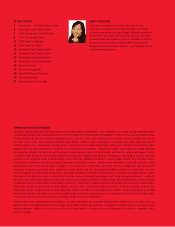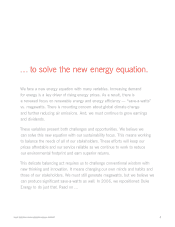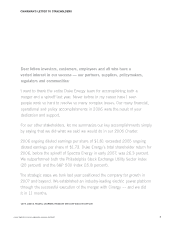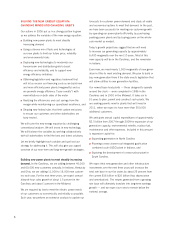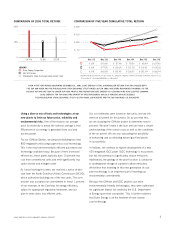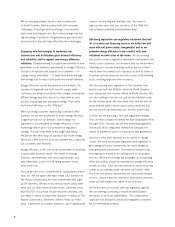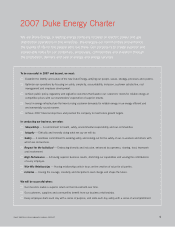Duke Energy 2006 Annual Report Download - page 9
Download and view the complete annual report
Please find page 9 of the 2006 Duke Energy annual report below. You can navigate through the pages in the report by either clicking on the pages listed below, or by using the keyword search tool below to find specific information within the annual report.
DUKE ENERGY 2006 SUMMARY ANNUAL REPORT 7
Using a diverse mix of fuels and technologies at our
new plants to limit our future price, reliability and
environmental risks. One of the reasons our average
price for electricity is below the national average is that
98 percent of our energy is generated from coal and
nuclear power.
For our Cliffside Station, we proposed building two new
800-megawatt units using supercritical coal technology.
This is the most environmentally efficient pulverized coal
technology available today. Because of their increased
efficiencies, these plants typically burn 10 percent less
coal than conventional units and emit significantly less
sulfur dioxide and nitrogen oxide.
As I was finishing this letter, we received a notice of deci-
sion from the North Carolina Utilities Commission (NCUC),
which authorized building one of the two units. The com-
mission also accepted our commitment to invest 1 percent
of our revenues in the Carolinas for energy efficiency,
subject to appropriate regulatory treatment, and our
plan to retire older, less efficient units.
Our cost estimates were based on two units, and we still
need an air permit for this project. So as you read this,
we are studying the Cliffside project to determine how to
proceed. We won’t make a decision until we have a clearer
understanding of the overall costs as well as the conditions
of the air permit. We are also evaluating the possibility
of enhancing and accelerating natural gas-fired plants
in our portfolio.
In Indiana, we continue to explore development of a new
630-megawatt IGCC plant. IGCC technology is less proven,
but has the potential to significantly reduce emissions.
Additionally, the geology of the plant location is conducive
to underground storage of captured carbon emissions.
We believe that investing in this next generation of coal-
plant technology is an important part of meeting our
environmental commitments.
Because the Cliffside and IGCC projects use more
environmentally friendly technologies, they were authorized
for significant federal tax credits by the U.S. Department
of Energy upon their completion. This is further evidence
that Duke Energy is on the forefront of new cleaner
coal technology.
COMPARISON OF FIVE-YEAR CUMULATIVE TOTAL RETURN
COMPARISON OF 2006 TOTAL RETURN
OVER A FIVE-YEAR PERIOD BEGINNING DECEMBER 31, 2001, DUKE ENERGY’S TOTAL SHAREHOLDER RETURN (TSR) HAS LAGGED BOTH
THE S&P 500 INDEX AND THE PHILADELPHIA STOCK EXCHANGE UTILITY INDEX. BUT, IN 2006, INVESTORS RESPONDED FAVORABLY TO THE
DECISIVE ACTIONS WE TOOK TO LOWER OUR RISK PROFILE AND REPOSITION DUKE ENERGY AS A LEADING PURE-PLAY ELECTRIC COMPANY.
DUKE ENERGY’S TSR FOR 2006 (PRE-SPINOFF OF SPECTRA ENERGY) WAS 26.3 PERCENT, WHICH EXCEEDED
THE PHILADELPHIA STOCK EXCHANGE UTILITY SECTOR INDEX (20 PERCENT) AND THE S&P 500 INDEX (15.8 PERCENT).


